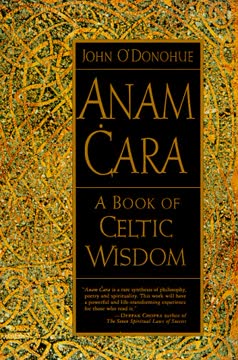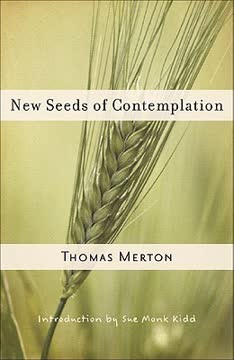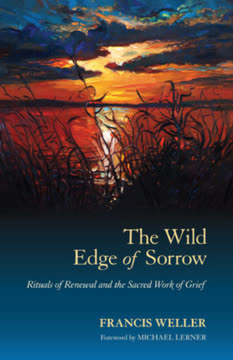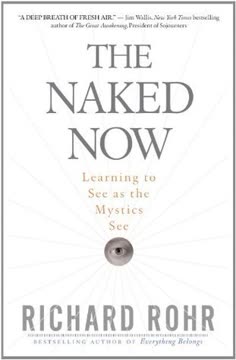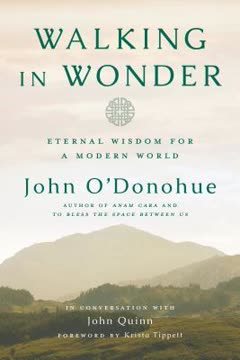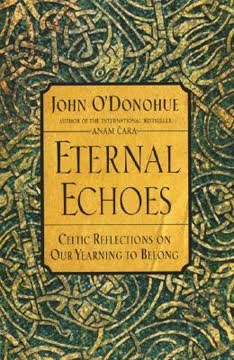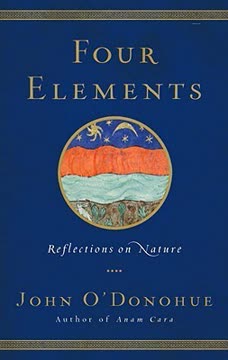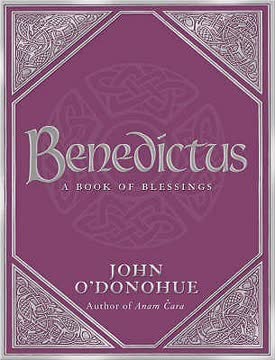Key Takeaways
1. Anam Cara: The Sacredness of Soul Friendship
In the Celtic tradition, there is a beautiful understanding of love and friendship. One of the fascinating ideas here is the idea of soul-love; the old Gaelic term for this is anam ċara.
Soul friend. The core concept of Celtic wisdom is the anam ċara, or soul friend. This is a person to whom you can reveal the hidden intimacies of your life without mask or pretension. It's a friendship based on deep recognition and belonging, cutting across conventional boundaries.
Ancient connection. Anam ċara friendship is an act of ancient recognition, as if two souls, separated long ago, finally find their way back to each other. This bond is not limited by distance or time; it exists on a soul level where unity is not easily severed. It's a sacred kinship where two souls are twinned, becoming porous to each other's presence.
Divine intimacy. This profound friendship mirrors the nature of God, understood in the Christian Trinity as an eternal interflow of intimacy and otherness. Love, in this sense, is not sentimental but the most real and creative form of human presence, a threshold where the divine and human meet. It's the light that reads the secret signature of another's soul.
2. The Body: Soul's Angel and Sacred Home
Your body is your clay home; your body is the only home that you have in this universe.
Body as sanctuary. The human body is not merely a vessel for the soul but is itself sacred, the soul's angel and its only home on earth. It is a visible sign of invisible grace, a sacrament where the unseen world finds expression. Unlike dualistic views that see the body as a source of negativity, Celtic wisdom sees it as infused with wild and vital divinity.
Truthful mirror. The body is profoundly truthful, often revealing the state of our inner life more honestly than our minds. It possesses a luminous intelligence and knows our spirit intimately. Illnesses can sometimes stem from neglecting the body's voice, which speaks truths beneath the surface of our external lives.
Body in the soul. The more ancient perspective is that the body is in the soul, not the other way around. The soul suffuses the body completely, creating a secret and beautiful soul-light around us. This recognition invites a new art of prayer, drawing this soul-light into the physical self for healing and renewal.
3. The Senses: Thresholds to the Divine
Being in the soul, the body makes the senses thresholds of soul.
Gateways to soul. Our senses are not just tools for perceiving the external world but are sacred thresholds connecting us intimately with the divine within and around us. To be sensual or sensuous is to be in the presence of your own soul. Attuning to the wisdom of the senses prevents us from becoming exiles in our own lives.
Transfiguring perception. Each sense offers a unique way to encounter reality and ourselves.
- Sight: The eye is the mother of distance and intimacy, bringing the world close. How we see determines who we will be; the loving eye sees reality.
- Taste/Speech: The tongue connects taste and language; a dulled sense of taste mirrors impoverished language.
- Smell/Breath: Smell is immediate and linked to memory; breath is the pathway of spirit, connecting us to the divine ground.
- Hearing: Listening connects us to silence and the music of the universe; true listening is worship.
- Touch: Touch breaks distance, bringing intimacy and belonging; it is the language of connection and healing.
Holiness is mindful sensing. Holiness is not found in abstract concepts but in the mindful engagement of our senses with the world. This spirituality of the senses is an art of transfiguration, allowing the wildness of eros and the playfulness of the soul to come into lyrical rhythm.
4. Solitude: Luminous Hearth of the Soul
Solitude is one of the most precious things in the human spirit. It is different from loneliness.
Homecoming to self. Solitude is not merely the absence of others but a luminous space within, a homecoming to our deepest belonging. Unlike loneliness, which is the painful awareness of separation, solitude reveals a point of absolute nonconnection within each person that can only be filled by the divine.
Inner hearth. Within everyone's inner solitude is a bright and warm hearth, a place of welcome and return. This is the soul's primal energy, a source of warmth and welcome. Engaging this inner space requires courage to face the "demons" (untransfigured aspects) which, when befriended, reveal precious blessings.
Natural holiness. To be natural is to be holy, to be at home with your own nature. Avoiding solitude keeps us outside ourselves, missing the call of our own mystery. When we settle into the mystery of solitude, relationships deepen, and we discover that we are never truly alone, but intimately connected to the rhythm of the universe.
5. Work: Poetics of Inner Expression
Our nature longs deeply for the possibility of expression in what we call work.
Expression of soul. Work should be the arena where the soul can enjoy becoming visible and present, where the rich, unknown inner world finds outer form. It's a fundamental human desire to bring the invisible within to expression through action.
Beyond function. Too often, work is an anonymous place of function and control, leaving individuals feeling like mere functionaries. This can lead to weariness and a sense of being caged. True work engages creativity, welcomes individual gifts, and contributes to the larger community, moving beyond competition towards shared enrichment.
Imagination in work. The imagination is vital for transforming work. It sees possibilities where linear thinking sees only repetition. Approaching work with imaginative possibility, rather than just analysis, can re-energize individuals and projects, making spontaneity and creativity major forces.
6. Aging: Harvesting the Soul's Memory
Aging is not merely about the body losing its poise, strength, and self-trust. Aging also invites you to become aware of the sacred circle that shelters your life.
Inner harvest. Aging is the autumn of life, a time for harvesting the fruits of experience. It's an invitation to gather lost moments and integrate the past, bringing unity and a new sense of strength and poise. While the body ages, the soul grows richer, deeper, and stronger.
Memory's temple. Memory is the sacred place where our vanished days secretly gather. It's an inner temple of feeling and sensibility, not just storage and recall. Old age offers the time to visit this temple, integrating experiences, including wounds and mistakes, with compassion and forgiveness.
Second innocence. Aging can bring a second innocence, a wholesome and hopeful outlook gained after navigating life's difficulties. It's a time of ripening, meeting oneself perhaps for the first time, and releasing false burdens to experience greater inner freedom.
7. Death: The Unknown, Intimate Companion
The name of this presence is death.
Lifelong companion. Death is not just an event at the end of life but a presence that walks with us from birth, shadowing every moment. Our physical death is the completion of a process death has been working on all along.
Faces of death. Death manifests in everyday life through negativity, fear, and the impulse to control. Transfiguring these aspects of ourselves means befriending the faces of our own death. This process ensures that physical death, when it arrives, is not a stranger but a meeting with a lifelong friend from the deepest side of our nature.
Beyond fear. All fear is rooted in the fear of death, which is amplified by life's unpredictability. Our culture often denies death, fostering a cult of immortality. However, facing and transfiguring fear allows us to reclaim power and approach death not as a terrifying unknown, but as a natural, albeit mysterious, transition.
8. The Eternal: Woven into Daily Life
The eternal is at home—within you.
Not elsewhere. The eternal is not a distant realm but is intimately present, woven into the fabric of our daily lives and within our own souls. Celtic wisdom saw the visible and invisible worlds, time and eternity, as fused and participating in each other.
Different rhythm. Eternal time moves differently than linear, mortal time. While our days vanish, they are caught and held by the net of the eternal in our soul, gathered and preserved in memory. This eternal dimension within us is not vulnerable to the ravages of normal time.
Homecoming. The awakening of the human spirit is a homecoming to this eternal presence within. Familiarity can blind us to this mystery, but viewing ourselves and our lives with fresh eyes reveals the strangeness and depth of the eternal that awaits us, always near.
9. Imagination: Bridge Between Worlds
The imagination is the faculty that bridges, co-presents, and co-articulates the visible and the invisible.
Creative force. Imagination is the soul's creative force, navigating the thresholds between light and dark, known and unknown, possibility and fact. It is the great friend of possibility, preventing reality from hardening into fixed forms.
Inner landscape. The imagination shapes and peoples our inner life, creating depth experience. It is native to the rhythm between the ancient and the new within us, initiating conversation between conflicting inner forces to birth something original.
Reverent mirror. Imagination is the most reverent mirror of the inner world, understanding that inner divinity finds expression in symbolic form. It allows us to participate imaginatively in the possibility of things, including the negative, helping us build creative friendships with all aspects of experience.
10. Negativity and Difficulty: Disguised Gifts for Growth
Rilke used to say that difficulty is one of the greatest friends of the soul.
Beyond avoidance. We often try to avoid or remove negativity and difficulty, but this only traps them within. What we call negative is often the surface form of contradiction, which holds secret light and vital energy for growth.
Transfiguration. The key is not to eliminate but to transfigure negativity, turning it toward the light of the soul. This process, often slow and unpredictable, allows the negative side to become a force for renewal and creativity, contributing to who we are.
Hidden treasures. Difficulties and unwanted situations are often disguised opportunities for growth, holding the light of a great jewel within them. Embracing the awkward and difficult with hospitality, rather than resistance, reveals these hidden treasures and leads to deeper understanding and healing.
Last updated:
FAQ
1. What is "Anam Cara: A Book of Celtic Wisdom" by John O’Donohue about?
- Exploration of Celtic Spirituality: The book delves into the ancient wisdom and spirituality of the Celtic tradition, focusing on themes of friendship, belonging, and the soul.
- Concept of Anam Ċara: Central to the book is the Gaelic concept of "anam ċara," meaning "soul friend," and how this deep, spiritual friendship can transform our lives.
- Lyrical and Philosophical Approach: O’Donohue blends poetry, philosophy, and personal reflection to offer a lyrical meditation on the human experience, nature, and the divine.
- Structure and Themes: The book is organized around key life stages and experiences—friendship, the senses, solitude, work, aging, and death—each explored through a Celtic lens.
2. Why should I read "Anam Cara: A Book of Celtic Wisdom" by John O’Donohue?
- Deepens Understanding of Self: The book encourages readers to explore their inner world, fostering self-awareness and spiritual growth.
- Offers Timeless Wisdom: O’Donohue draws on Celtic tradition to provide insights into love, friendship, and the meaning of life that are relevant across cultures and eras.
- Healing and Inspiration: The poetic language and gentle guidance offer comfort, healing, and inspiration, especially for those seeking meaning or going through transitions.
- Practical Spirituality: The book provides practical advice for living more mindfully, nurturing relationships, and embracing the sacred in everyday life.
3. What are the key takeaways from "Anam Cara: A Book of Celtic Wisdom"?
- Soul Friendship is Transformative: The concept of anam ċara teaches that deep, authentic friendship is a sacred bond that nurtures the soul.
- Unity of Body and Soul: O’Donohue emphasizes that the body is not separate from the soul; rather, the body is in the soul, and both are sacred.
- Embrace of Paradox and Mystery: The Celtic worldview values the coexistence of light and darkness, joy and sorrow, and the acceptance of life’s mysteries.
- Importance of Belonging and Solitude: True belonging comes from within, and solitude is seen as a luminous, creative space rather than a source of loneliness.
4. How does John O’Donohue define "anam ċara" (soul friend) in the book?
- Ancient Gaelic Concept: "Anam ċara" literally means "soul friend" in Gaelic, referring to a person with whom one can share the deepest aspects of the self.
- Beyond Conventional Friendship: This relationship transcends social categories, time, and space, offering unconditional acceptance and understanding.
- Spiritual and Transformative Bond: The anam ċara is someone who helps you recognize your true self, supports your spiritual journey, and awakens your inner potential.
- Divine Dimension: O’Donohue links the anam ċara to the divine, suggesting that such friendships reflect the nature of God as ultimate friendship and belonging.
5. What is the Celtic view of the soul and its relationship to the body, according to "Anam Cara"?
- Body is in the Soul: O’Donohue reverses the common Western notion, asserting that the body is contained within the soul, not the other way around.
- Sacredness of the Body: The body is seen as a sacred home, a visible sign of invisible grace, and deserving of reverence and care.
- Unity of Visible and Invisible: The Celtic tradition does not separate the spiritual from the physical; both are intertwined and equally real.
- Senses as Thresholds: The senses are described as thresholds of the soul, gateways through which we experience the divine in the world.
6. How does "Anam Cara" by John O’Donohue approach the theme of friendship?
- Friendship as Sacred Encounter: True friendship is seen as a sacred, creative force that brings out the best in each person and fosters spiritual growth.
- Act of Recognition: Real friendship is described as an act of ancient recognition, where two souls remember their deep connection.
- Beyond Sentimentality: O’Donohue warns against reducing friendship to sentimentality or utility, emphasizing its transformative and subversive power.
- Friendship with Self: The book also stresses the importance of befriending oneself, cultivating inner kindness, and embracing one’s own complexity.
7. What role do the senses play in Celtic spirituality, as described in "Anam Cara"?
- Senses as Spiritual Gateways: The senses are viewed as sacred thresholds that connect us to the divine and to the world around us.
- Celebration of Sensuousness: Celtic spirituality encourages a full embrace of the senses—sight, taste, touch, hearing, and smell—as sources of joy and wisdom.
- Transfiguration, Not Denial: Rather than denying the senses, the Celtic tradition seeks to transfigure them, allowing them to reveal deeper spiritual realities.
- Integration with Nature: The senses are a means of experiencing the unity of all creation, fostering a sense of belonging and reverence for the earth.
8. How does John O’Donohue in "Anam Cara" view solitude and its importance?
- Solitude as Luminous: Solitude is portrayed as a luminous, creative space where one can encounter the depths of the soul and the divine.
- Distinction from Loneliness: O’Donohue distinguishes between loneliness (a sense of lack) and solitude (a state of fullness and presence).
- Source of Creativity: Solitude is seen as essential for self-discovery, healing, and the cultivation of inner richness.
- Noninterference and Acceptance: The book advocates for a gentle, non-intrusive approach to one’s inner life, allowing the soul to unfold naturally in solitude.
9. What guidance does "Anam Cara" offer about work and creativity?
- Work as Poetics of Growth: Work is viewed as an opportunity for the soul to express itself and for the invisible to become visible.
- Importance of Imagination: O’Donohue emphasizes the role of imagination in transforming work from mere function to creative expression.
- Dangers of False Belonging: The book warns against losing oneself in roles or systems, advocating for authentic engagement and balance.
- Heartful Work: Bringing love and presence to one’s work is seen as a way to create beauty, healing, and fulfillment.
10. How does "Anam Cara" by John O’Donohue address aging and the passage of time?
- Time as a Circle: The book presents time as a circular, rather than linear, process, mirroring the cycles of nature and the soul.
- Aging as Inner Harvest: Aging is described as a time of gathering wisdom, integrating experiences, and coming home to oneself.
- Memory as Sacred: Memory is honored as the temple where the soul gathers and preserves the richness of life.
- Embracing Second Innocence: O’Donohue encourages embracing a "second innocence" in old age—a return to wonder, openness, and self-compassion.
11. What is the Celtic perspective on death and the afterlife in "Anam Cara"?
- Death as Companion: Death is seen as a lifelong companion, not a distant event, and is integrated into the rhythm of life.
- Thin Veil Between Worlds: The Celtic tradition views the boundary between life and death as thin, with the dead remaining close to the living.
- Death as Homecoming: Dying is described as a return to the eternal home, a release into the fullness of the soul’s belonging.
- Blessings and Rituals: The book highlights the importance of rituals, blessings, and communal support in facing death and mourning.
12. What are the best quotes from "Anam Cara" by John O’Donohue and what do they mean?
- "The anam ċara was a person to whom you could reveal the hidden intimacies of your life." — This highlights the depth and sacredness of soul friendship.
- "Your body is in the soul, and the soul suffuses you completely." — Emphasizes the unity and sacredness of body and soul in Celtic thought.
- "One of the greatest sins is the unlived life." — Encourages readers to embrace their unique destiny and live fully, rather than succumbing to fear or conformity.
- "May you recognize in your life the presence, power, and light of your soul." — A blessing that encapsulates the book’s message of self-discovery, belonging, and spiritual awakening.
Review Summary
Anam Cara is widely praised for its profound spiritual wisdom and poetic language. Readers appreciate O'Donohue's exploration of Celtic spirituality, friendship, and the soul. Many find the book deeply moving and transformative, returning to it repeatedly for insights. Some critics find it overly flowery or religious, but most reviewers highlight its beautiful prose and thought-provoking ideas. The book's contemplative nature and focus on inner reflection resonate strongly with many readers, who describe it as a source of comfort and inspiration in their lives.
Similar Books
Download PDF
Download EPUB
.epub digital book format is ideal for reading ebooks on phones, tablets, and e-readers.
